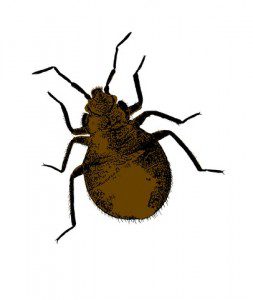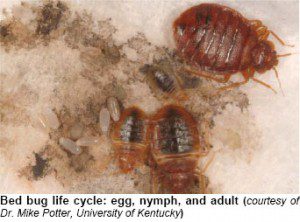Win the Bed Bug Battle Naturally
“Sleep tight, don’t let the bed bugs bite!” This phrase may bring back fond memories for some, but for thousands of people across the United States and elsewhere, it has become nothing less than a nightmarish reality.
Bed Bug History
Bed bugs have been wreaking havoc for thousands of years. They were mentioned in Greece as early as 400 B.C. and were brought to the Western Countries by the European Settlers. Upon the invention of DDT, a powerful and extremely toxic pesticide, they were almost completely eliminated in the West. In the 1990’s, following the ban of DDT, bed bugs made a comeback in cities like New York and San Francisco. They have since made their way across the U.S.A. and have invaded dormitories, hotels, apartments, and even the personal homes of unsuspecting families.
Bed Bugs vs. Dust Mites
First of all, please don’t confuse bed bugs with dust mites. They are two very different organisms. Dust mites are microscopic and feed on human skin cells. Bed bugs on the other hand can grow up to a quarter of an inch in size and are parasitic creatures. They feed off the blood of warm-blooded animals or humans. They can cause a whole host of allergic reactions in those who sleep in their presence. Bed bugs have also been known to carry pathogens for several diseases such as anthrax, plague, yellow fever, and typhus. However, there is no conclusive scientific proof linking bed begs to the spread of these diseases.
Bed Bug Identification
- Adults are broad, oval, with a wingless flat body and are about 4-5 mm long and 3 mm wide.
- They range in color from brown to reddish brown (after a meal of blood)
- They give off a distinct, disagreeable, sweet odor when crushed.
- The nymphs appear translucent or pale in color before a feeding and resemble adults, but are much smaller.
- They shed their skins leaving behind a light brown shell.
Checking your Home for Bed Bugs
Most people don’t realize they have a problem unless they are noticing the itchy bites on their skin. Bed bugs are very small and are very good at hiding in cracks and crevices. They also do not like light, so they will rarely be out where you can see them.
How to spot check your bed
- Peel back the sheets
- Run your fingers along the upper and lower seams of the mattress
- Look around the mattress tags
- Check behind your headboard and under your bedside tables.
What to look for
- Black poppy seed sized spots (hatchlings)
- Translucent bug skins (moltings)
- Adult Bed Bugs Bed
- Bug fecal matter
Bed bug fecal matter is dark brown to black and it sticks to the surface. If it falls off easily it is something else. You can also use a moist towel and if it smears, it is most likely fecal matter. When traveling check your hotel beds as well. Be sure to use the suitcase stands, which keep your clothes from coming into contact with possible pests.
How to Eliminate Bed Bugs
If you find any signs of bed bugs, you unfortunately have very few options. Bed bugs are some of the most resilient creatures on the planet and are terribly hard to get rid of. Hatchlings can go weeks without eating and the adults can live up to a year with out a meal! I would recommend spending the money to have a professional come in and take care of the problem. To date there is no natural remedy that will kill bed bugs other than extreme heat and extreme cold. Find a professional who uses steam heat and not pesticides to kill the bed bugs. Pesticides are chemicals and they are toxic carcinogens that you don’t want in your home. Pesticides have been linked to a whole host of illnesses, including Cancer and Parkinson’s disease.
Bed Bug Prevention is Key
Truly, the best way to treat bed bugs is prevention. Thankfully, there are several natural remedy options in the prevention of bed bugs.
Keep a clean and sanitary environment
- Wash your bedding regularly
- Fold your bedding into itself when you gather up your sheets trapping anything inside.
- Wash your bedding in hot water
- Dry on the hottest setting for at least 25 minutes. Extreme heat can kill bed bugs and their hatchlings.
- Vacuum regularly around and under your bed.
Many professionals also recommend purchasing a mattress cover. Any cover that specifies use for allergy and dust mites will work for bed bugs. There is no need spend the extra money on a “bed bug” approved cover. If it works for microscopic dust mites, it will work for the much larger bed bugs. Your local superstore should carry just what you need.
Bed beds cannot jump or fly. They usually crawl from the floor up into your bed. Cover your bed support legs with a one-inch strip of petroleum jelly and they will get stuck in it. This is a virtually cost free and effective solution.
Essential Oils for Bed Bugs
Another easy and natural remedy to deter bed bugs is using essential oils. There are many essential oils that stave off all kinds of bugs ranging from spiders to ants and even the dreaded bed bugs!
- Tea tree
- Lavender
- Eucalyptus
- Cedarwood
- Thyme
You can use the essential oils alone or in combination for stronger bed bug prevention. There are several ways to use the oils as well; one would be to make a bed bug spray.
Bed Bug Spray
- 20 drops of essential oils (one or combination)
- 4 oz of distilled water
- 1 tbsp of vodka or grain alcohol (for preservation)
Mix all the ingredients in a small spray bottle and shake. Shake before use and mist your linens every 3-4 days and let it dry before retiring to bed. This mixture is great to travel with, as well.
Additional Bed Bug Prevention Techniques
- Another option would be to mix baking soda with several drops of essential oil and put the mixture in a cotton sachet or empty cotton tea bag. You can put these on the underside of your mattress.
- You could also fill sachets with the actual dried herbs and not only put them underneath the mattress, but also around headboard and in your nightstand drawers. Many of you may have lavender growing around your home giving you a cheap and easy deterrent at your fingertips.
- One last option for using essential oils is to put several drops in a diffuser, which releases the fragrance into the air. The nice part about these oils is that they have medicinal effects on you while you’re discouraging bugs!
-
- Lavender is great for relaxation and stress relief
- Eucalyptus works for respiratory problems and headaches
- Cedarwood and thyme are both antiseptics
Though even the thought these menacing pests can evoke disease, fear and trembling in many people, the solution is simple and easy: Bed Bug Prevention. Using natural remedy essential oils and keep your sleeping area clean and sanitary can keep those bed bugs at bay and will truly help you, “Sleep tight and not let the bed bugs bite.”













